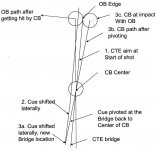Spidey,
I'd be happy to add some of your comments to the
CTE resource page, and I'd be happy to change your posting that is already quoted there. However, I'm hoping you can clarify a few things. And please don't start the whole "spoon feeding" sob story again. I just want you to explain what you really mean by a few of your phrases and statements. I'd rather not add things to the resource page that create more questions than answers. Although, I am happy to post a clear procedure, explanation, and illustrations for your version of CTE if you want to provide it. I don't want you to keep explaining how other versions (e.g., the ones already posted) don't work. We already know they don't work without "adjustments." I'd rather you focus on clearly explaining how your version does work.
I hope it doesn't offend you ... that's not my intent.
Regards
Dave
That sounds fancy, but the exact meaning is not clear, IMO. I think "effective pivot length" (see the
resource page) explains some of the things you are describing here, but i'm not sure. It seems like all of this stuff (the subtle changes in alignment and pivot needed to pocket a wide range of shots) must require judgment and "feel" based on "visual intelligence" (e.g., the ability to "see" the "angle of the shot" or "required line of aim").
... unless you vary your bridge length and/or "rotate" or "tilt" or "shift" or "deform" the bridge hand during the pivot (see Colin's animation).
If you are not pivoting to the center of the CB, then how do you decide where to stop? And if you don't pivot to center-ball, you will be adding English to the shot. If so, how do you compensate for the resulting squirt, swerve, and throw?
Again, without a diagram or detailed explanation, this doesn't make much sense.
There seem to be many variations and interpretations of "CTE" out there. You obviously don't agree with the versions posted on the resource page. If you were to describe, illustrate, and demonstrate your version of "CTE," I would be happy to add it to the page. Until then, all we have to go on is what has already been provided by others.
Again, I don't think it is really clear what this means, but I will add it to your quote when I get a chance.
Again, you are creating a different "effective pivot length" by how you pivot (see the resource page for more info).
As with the pivot, it seems like the alignment and eye position needs to be just right to get the right amount of pivot for the "effective pivot length" you are using for a given shot.
This is where it sounds like magic again. If you don't take into account how much you need to cut the ball, and change your alignment and/or pivot to adjust to the amount of cut needed, your version of CTE sounds too good to be true.
Regards,
Dave

